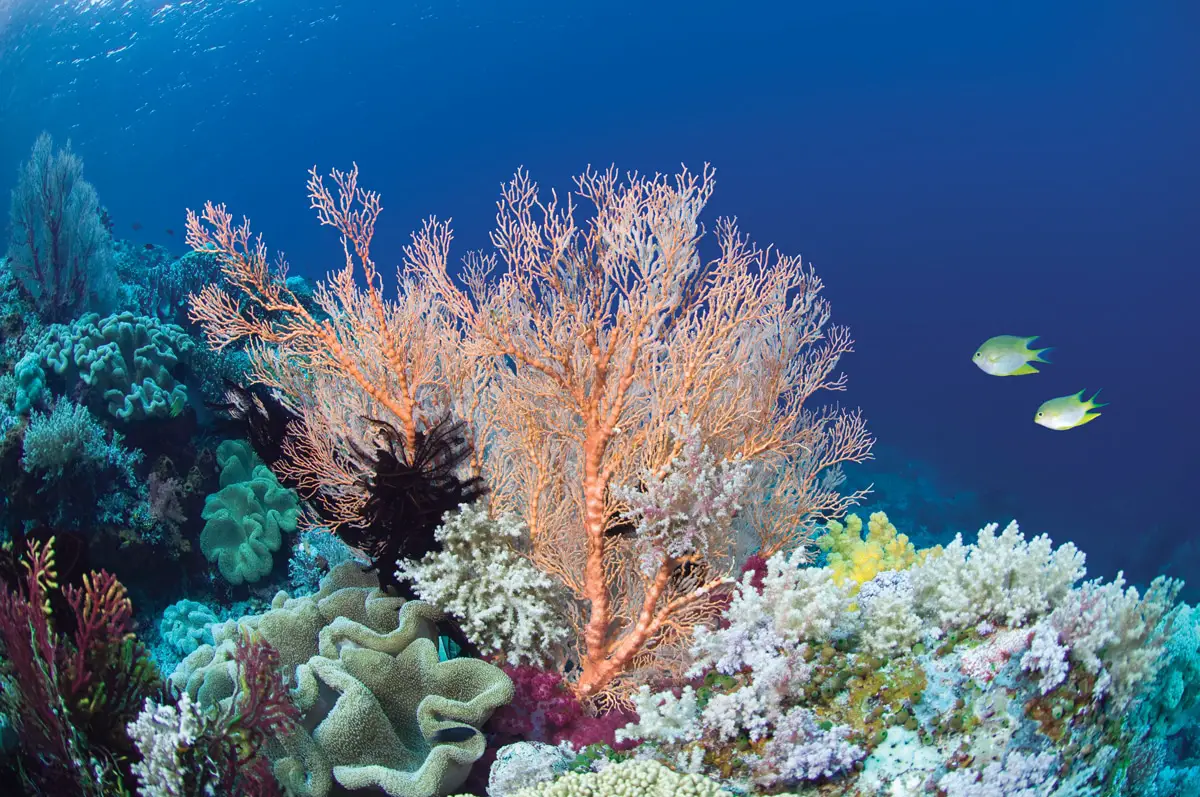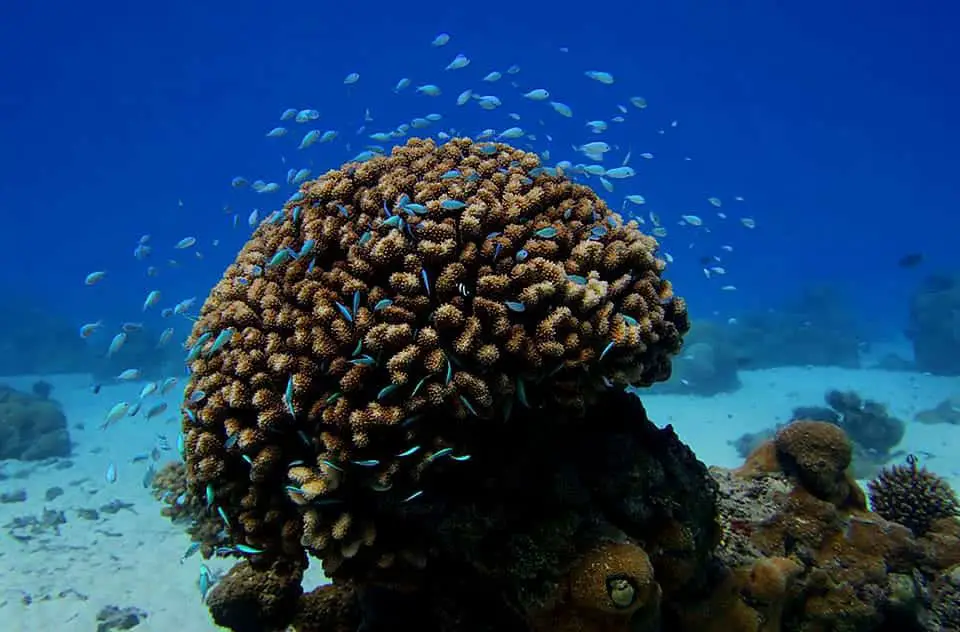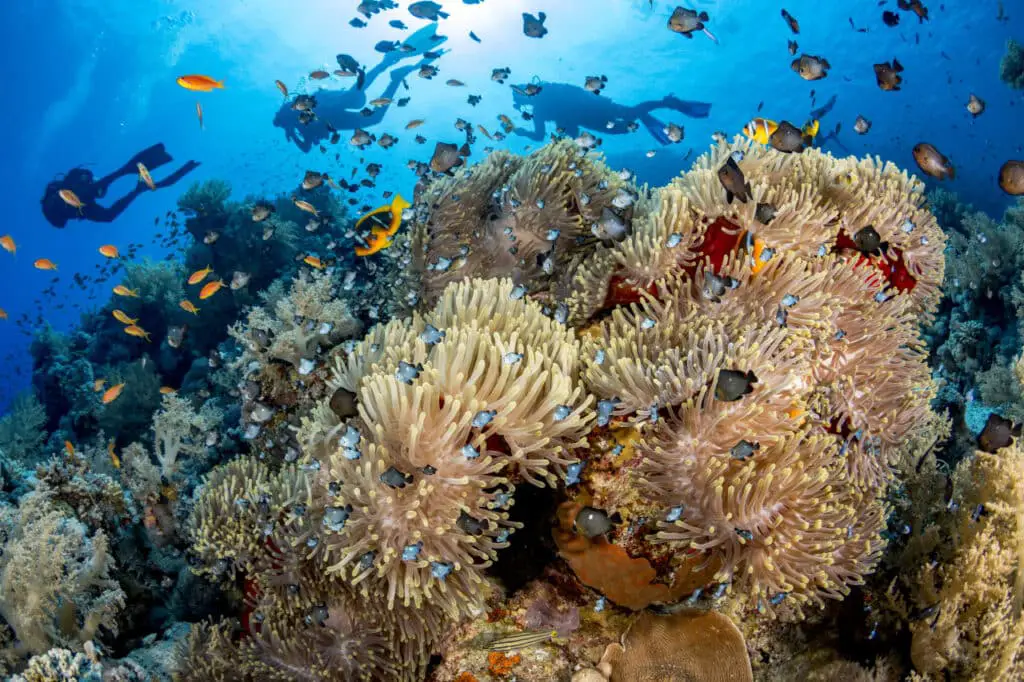How Does Coral Survive In The Ocean

Introduction
How Does Coral Survive In The Ocean: Coral reefs are among the most diverse and ecologically significant ecosystems on our planet. These vibrant underwater communities, often referred to as the “rainforests of the sea,” house a myriad of marine species and play a crucial role in maintaining the health of the oceans. However, these delicate organisms face numerous challenges in their quest for survival in the harsh underwater environment.
Coral, a colonial organism comprising thousands of tiny polyps, has developed remarkable strategies to endure and thrive in the ocean’s ever-changing conditions. One of the most extraordinary aspects of coral survival is its symbiotic relationship with photosynthetic algae known as zooxanthellae.
These microscopic algae live within the coral’s tissues, harnessing sunlight to produce energy through photosynthesis. In return, the coral provides shelter and essential nutrients to the algae. This mutualistic partnership not only allows coral to thrive in nutrient-poor waters but also imparts the vibrant colors that characterize healthy reefs.
Coral also possesses a remarkable ability to calcify, secreting calcium carbonate to build their skeletons. Over time, these skeletons accumulate, forming the intricate structures that make up coral reefs. Despite facing numerous threats such as rising ocean temperatures, ocean acidification, and pollution, coral’s survival strategies continue to captivate scientists and conservationists alike.

What does coral need to survive in the ocean?
Most reef-building corals also require very saline (salty) water ranging from 32 to 42 parts per thousand. The water must also be clear so that a maximum amount of light penetrates it. This is because most reef-building corals contain photosynthetic algae, called zooxanthellae, which live in their tissues.
Coral reefs are remarkable and fragile ecosystems, and for coral to thrive in the ocean, several essential factors must be in place. These requirements are crucial for their survival and continued growth:
- Sunlight: Coral reefs are typically found in shallow, clear waters where sunlight can penetrate. Sunlight is essential for photosynthesis, a process that sustains coral by providing energy and nutrients through a symbiotic relationship with photosynthetic algae called zooxanthellae.
- Warm Water: Coral reefs thrive in warm, tropical waters with temperatures typically ranging from 23°C to 29°C (73°F to 84°F). These temperatures are conducive to the metabolic processes of both coral and the zooxanthellae.
- Clear Water: Coral depends on clear, clean water to receive sufficient sunlight for photosynthesis. Sediment runoff, pollution, and excessive nutrients can block sunlight and harm coral health.
- Stable Conditions: Coral is sensitive to sudden changes in water temperature, salinity, and acidity. Stable environmental conditions are essential for their growth and survival.
- Calcium Carbonate: Coral skeletons are made of calcium carbonate (aragonite), which they extract from the surrounding water. Adequate levels of calcium and carbonate ions in the water are crucial for coral growth and reef development.
Understanding these requirements and taking steps to protect coral reefs is essential to ensure the continued existence of these diverse and vital marine ecosystems.
How can corals survive?
Most reef-building corals depend upon zooxanthellae (tiny little algae that grow inside of them) to photosynthesize and provide food. If the water becomes cloudy or murky, or if corals are covered in sediment, the sunlight can’t get to the zooxanthellae and the corals lose that important food source.
Coral survival is a fascinating testament to the adaptability of these complex organisms within the challenging marine environment. Several key factors contribute to how corals can survive:
- Symbiotic Relationships: Coral polyps form symbiotic relationships with photosynthetic algae called zooxanthellae. This partnership allows corals to harness the energy produced through photosynthesis, which not only provides them with nutrients but also imparts the vibrant colors associated with healthy coral reefs.
- Calcification: Corals have the unique ability to secrete calcium carbonate, which they use to build their skeletons. Over time, these skeletons accumulate, forming the sturdy and intricate structures that make up coral reefs. This calcification process is crucial for their growth and survival.
- Feeding Strategies: While corals rely significantly on their symbiotic algae for nutrition, they can also capture plankton and other tiny organisms using their tentacles and stinging cells. This supplemental feeding strategy helps corals obtain additional nutrients when necessary.
- Adaptation to Environmental Stress: Some coral species exhibit remarkable adaptability to environmental stressors, such as temperature fluctuations. They can undergo genetic changes over generations to better withstand these challenges.
- Reproductive Strategies: Corals reproduce both sexually and asexually. Sexual reproduction results in the production of larvae that can settle and form new colonies. Asexual reproduction, like fragmentation, allows corals to recover from damage and expand their colonies.
How does coral come back to life?
Warmer waters can trigger a coral bleaching where the coral turns white as it expels the symbiotic food-producing algae living in its tissues. Prolonged bleaching events often cause corals to die from starvation, but they can recover if they reclaim their food source within a few weeks.
The process of coral “coming back to life” primarily refers to coral recovery or restoration efforts, as coral colonies are living organisms. Coral recovery is a complex and often challenging process, especially in the face of threats like coral bleaching, disease, and habitat degradation. Here’s an overview of how coral can recover:
- Natural Regeneration: Some coral species have a natural ability to recover from stressors like coral bleaching. When environmental conditions improve, these corals can regain their color and vitality as symbiotic algae return to their tissues.
- Coral Resilience: Research suggests that certain coral populations may possess genetic traits that make them more resilient to stressors. These “super corals” can recover more effectively and potentially serve as a source of genetic diversity for future restoration efforts.
- Coral Restoration: Human-assisted coral restoration involves techniques like coral nurseries and coral transplantation. Coral fragments are grown in nurseries and then replanted onto damaged reefs, helping to speed up recovery.
- Coral Spawning and Larval Restoration: Scientists are developing methods to collect coral spawn and rear coral larvae in controlled environments. These larvae can then be released onto degraded reefs, allowing them to settle and grow into new coral colonies.
- Coral Disease Management: Efforts to combat coral diseases involve removing infected coral tissue and applying treatments to reduce disease spread. These measures can help corals recover and prevent further disease outbreaks.
- Habitat Protection and Management: Preserving the overall health of coral reef ecosystems is essential for coral recovery. Strategies include protecting marine protected areas, regulating fishing practices, and reducing pollution to minimize stress on coral reefs.
What eats coral in the ocean?
Fish, marine worms, barnacles, crabs, snails and sea stars all prey on the soft inner tissues of coral polyps. In extreme cases, entire reefs can be devastated if predator populations become too high. Coral reefs may recover from periodic traumas caused by weather or other natural occurrences.
Coral reefs, often referred to as the “rainforests of the sea,” are intricate ecosystems teeming with life. While coral polyps are the primary builders of these majestic underwater structures, they are not exempt from being on the menu for various oceanic creatures.
One of the most prominent coral predators is the Crown-of-Thorns Starfish (Acanthaster planci). These large, spiky echinoderms have a voracious appetite for coral polyps, and when their populations explode, they can devastate entire coral reefs. Natural predators like certain species of fish, triton snails, and some sea stars help control their numbers.
Parrotfish are another group of coral consumers. These colorful fish possess powerful beaks capable of crushing and grinding coral. While they feed on the algae covering the coral, their actions inadvertently aid in coral growth by preventing algae overgrowth.
In the absence of natural predators or due to environmental stressors like pollution and rising sea temperatures, coral-eating organisms can become a significant threat to the health of these vital marine ecosystems. Therefore, conserving coral reefs and their intricate food webs is crucial for maintaining the biodiversity and overall well-being of our oceans.
What kills coral in the ocean?
Pollution, overfishing, destructive fishing practices using dynamite or cyanide, collecting live corals for the aquarium market, mining coral for building materials, and a warming climate are some of the many ways that people damage reefs all around the world every day.
Coral reefs, often referred to as the “rainforests of the sea,” are complex and delicate ecosystems teeming with biodiversity. Unfortunately, these remarkable underwater landscapes face numerous threats, both natural and human-induced, that can lead to their decline and, ultimately, their demise.
One of the primary culprits in the degradation of coral reefs is climate change. Rising sea temperatures due to global warming trigger a phenomenon known as coral bleaching. When corals expel the symbiotic algae living within their tissues in response to stress, they lose their vibrant colors and become vulnerable to disease. Prolonged or severe bleaching events can lead to coral death.
Human activities also play a significant role in coral reef degradation. Overfishing, destructive fishing practices, and coastal development can damage coral habitats and disrupt the delicate balance of these ecosystems. Pollution from agriculture, sewage, and industrial runoff introduces harmful chemicals and sediments into the ocean, further compromising coral health.
Coral reefs face a multitude of threats, with climate change, pollution, overfishing, and habitat destruction being among the leading causes of coral mortality in our oceans. Protecting these vital ecosystems requires concerted global efforts to reduce carbon emissions, regulate fishing practices, and promote sustainable coastal development.
What are the basic requirements for coral survival?
Coral survival hinges on several fundamental factors crucial for their health and well-being. Firstly, corals necessitate warm and stable water temperatures within a narrow range of 73 to 84 degrees Fahrenheit (23-29°C). Consistent warmth supports their symbiotic relationship with photosynthetic algae, which provide corals with essential nutrients.
Secondly, corals rely on clear, nutrient-poor water for optimal survival. This clarity allows sunlight to penetrate the depths, aiding their photosynthetic partners. Excessive nutrients, often from pollution or agricultural runoff, lead to algal overgrowth, depriving corals of light and suffocating them.
Adequate sunlight is the third imperative. Corals, primarily found in shallow, sunlit waters, depend on sunlight for photosynthesis. This process is essential for their growth, calcium carbonate production, and overall vitality.
The interplay of these factors is delicate, and any disruption can lead to coral stress or mortality. Preserving these basic requirements is imperative for safeguarding the fragile ecosystems that corals form, and ultimately, for the survival of these vital oceanic organisms.
How can we help protect coral survival in the ocean?
Preserving coral survival is crucial for the health of our oceans and the entire planet. There are several key ways in which we can contribute to their protection:
- Reduce Carbon Emissions: Climate change is a major threat to corals due to rising sea temperatures and ocean acidification. We can reduce our carbon footprint by using clean energy sources, minimizing car usage, and supporting policies aimed at carbon reduction.
- Limit Pollution: Runoff from agricultural and industrial activities introduces pollutants that harm corals. Proper waste disposal, sustainable farming practices, and supporting water quality regulations can mitigate this threat.
- Responsible Tourism: When visiting coral reefs, choose eco-friendly operators who adhere to sustainable tourism practices. Avoid touching or damaging the coral, and never anchor boats on reefs.
- Coral Reef-friendly Sunscreen: Certain chemicals in sunscreen can harm corals. Opt for reef-safe alternatives that do not contain oxybenzone and octinoxate.
- Support Marine Protected Areas: Advocate for the creation and proper management of marine protected areas (MPAs) that safeguard coral reefs from overfishing, pollution, and destructive activities.
By collectively taking these steps, we can play a vital role in preserving the delicate balance of coral ecosystems and ensuring their survival for future generations.
How do corals adapt to changing environmental conditions in the ocean?
Corals exhibit a range of remarkable adaptations to cope with changing environmental conditions in the ocean. One crucial mechanism is their symbiotic relationship with photosynthetic algae called zooxanthellae. These algae reside within the coral’s tissues and provide them with vital nutrients through photosynthesis.
When environmental stressors, such as elevated sea temperatures or increased UV radiation, occur, corals can expel their algae in a process known as bleaching. While bleached corals appear white and are temporarily weakened, they have the potential to recover if conditions improve.
Some corals also possess genetic diversity, allowing them to exhibit varying levels of resilience to stressors. This diversity enables certain colonies to better withstand environmental changes compared to others, contributing to the overall adaptability of coral populations.
While these adaptations showcase corals’ resilience, rapid and extreme environmental shifts, often driven by human activities, can outpace their capacity to adapt. Hence, concerted efforts to mitigate stressors and protect their habitats remain crucial for ensuring the long-term survival of these vital marine organisms.

Conclusion
Despite the immense challenges posed by the changing climate and human-induced stressors, coral reefs persist as vital ecosystems that support a wide range of marine life. The symbiotic relationship between coral and zooxanthellae, where coral provides shelter and nutrients while the algae produce energy through photosynthesis, is a remarkable strategy that enables coral to thrive in nutrient-deficient waters and provides the vibrant colors that enchant divers and scientists alike.
Rising ocean temperatures, ocean acidification, pollution, and destructive human activities threaten their very existence. To ensure the continued survival of these vital ecosystems, urgent global action is required. Conservation efforts, including marine protected areas, sustainable fishing practices, and reductions in greenhouse gas emissions, are essential to mitigate the impacts of climate change and other threats to coral reefs.
The story of how coral survives in the ocean is not just a fascinating tale of natural adaptation, but also a call to action. It serves as a reminder of the interconnectedness of all life on Earth and the importance of preserving our planet’s biodiversity. By safeguarding coral reefs and the oceans that house them, we can contribute to the well-being of both marine life and humanity, ensuring a sustainable future for generations to come.



